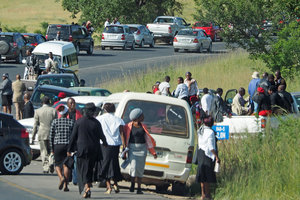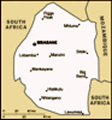Advertisement
Published: March 20th 2016

 Funeral Crowd
Funeral Crowd
Perhaps they would have invited us.This afternoon was a great highlight for our trip - we were entertained in a Swazi village near the entrance of
Mlilwane Wildlife Sanctuary. The chief (a 37-year-old widow) was out on royal business, so her daughter led the visit. The local guide, Sicuelo, and his assistant, Sonnboy, first dressed us appropriately by wrapping a cloth around our waist (women) or over one shoulder (men). Sonnboy knotted our wraps, taking care to have the printed image of the king right-side-up and right-side-out. Then we were led into the village. Sicuelo asked us to wait under a tree and not to wander because he had to seek permission for us to enter the village and the chief’s compound. Meanwhile, Sonnboy taught us how to respond to the greeting phrase.
After some time Sicuelo brought us into the compound where the chief’s daughter and about eight young women and boys greeted us, and we responded as taught. Then we were invited to sit on some mats in the shade of a hut and the reed wall. This was sturdy, made of reeds about 2 cm in diameter and seven feet tall joined together and to the thicker posts by tightly woven grass. Later we

 High Veldt
High Veldt
Rolling hills into the mountainsgot a chance to try weaving, which we would call braiding.
The chief’s daughter welcomed us at length and explained the chief’s absence, all translated by Sicuelo. (Later she spoke good English; perhaps English is not authentic enough for our reception.) Three or four young women (it varied) tried to teach us a women’s work song and a men’s work song - we were poor students! Next she got us up to dance, as well. I was pathetic at keeping rhythm. Seated again, we had a demonstration of several local household items and skills, even getting a few of us to balance baskets on our heads. All this was women’s work, so we had more fun, although our two male tourists were better dancers for their song. We got to try out grinding maize, which seemed easier than it probably is since the maize was already crushed; still the weight and shape of the stones (crusher and platform) were wonderfully balanced. All the time they work, the women sing in a melodious chant, giving rhythm to their labour. Finally we were invited to buy handicrafts to help the 150 orphans the chief supports. Some of our group were skeptical,

 Mud Weaver nests
Mud Weaver nests
Size of baseball, delicacy of lacebut I know Swaziland has a terrifyingly high AIDs rate.
I didn’t sleep well last night, overwhelmed by the intense safari experience yesterday. I was asleep around 10:00, but my sleep was disturbed by what I thought was entertainment for a large Dutch tour group staying at Timbavati. Later Duane said it was loud music from the village. Anyway, I woke refreshed enough (around 6:00) to do a set of stretches to avoid pain from sitting for long periods on the bus.
Every evening I am really tired, not just from all the activity but also from the emotional engagement and intellectual attention to so much new information. Routinely I have been going to sleep about ten and awakening at six.
Departure at 8:00 led us through diverse geographies and municipal entities. Everything in the "homelands" pertains to the Black economy. People working in the big cities who also want a home in their tribal area build the richest houses, and they carry obligations in their home villages. “Villages” refers to what I would call fairly substantial towns, although they don’t have any serious commercial core. Schools are located in good number throughout townships and homelands. More

 Swaziland on horizon
Swaziland on horizon
Higher than the High Veldtpeople walk here than in the cities such as Pretoria and Johannesburg, perhaps however only because this is Saturday. Bicycles are uncommon. Most of the cars are made in South Africa, one more robust industry spurred on by anti-apartheid sanctions (also the arms industry).
Not long after set-off we became embroiled in the traffic jam of a huge funeral. Duane had just finished telling us that wakes for funerals were parties that welcomed any person who wanted to come, even if they hardly knew the deceased. The line-up of cars extended about half a mile, and people were really well dressed. The women in our bus admired one woman’s hat so much they waved at her and pointed to her hat. She grinned a most pleased acknowledgment.
Our morning break was at
White River at a complex with a tourist bureau, several restaurants, and many shops. I bought a colourful silk scarf, ineffectually trying to bargain down the 200 Rand ($20) price. I don’t care enough.
Our lunch was at “
Cradle of Life”, a large restaurant and convention venue. On display were fossils million of years old, including one 3400 million years old. There have been finds in this area

 Near Swaziland
Near Swaziland
Change in land formationsthat have pushed back the dating of mankind by tens of thousands of years.
In the afternoon we went through another pass across the foothills of the Drakensburg Mountains, down into the low veldt, now much further east than a couple of days ago. The old mountain folds are covered in green grass. Here red stone outcrops distinguished this landscape from those of the past week – Dolomite rock from a crashed meteor, according to Duane.
Duane was fairly uptight because we were coming to the Swaziland border, where crossing can take ten minutes or three hours. As it happened, being a Saturday (Swazis who work in South Africa are already home), the crossing took five minutes on the South African side and 10 minutes on the Swazi side, no questions asked of us.
As we descended the mountains, the Swazi landscape became much more verdant. Unfortunately, Swaziland does little to cultivate its land riches or any others. Apparently 70% of Swazis are subsistence farmers. The main road was of modern design and well maintained, but our side road to the Swazi village was really rough, and the continuation into the game reserve was worse.
For

 Beehives of Swazi village
Beehives of Swazi village
A glimpse of our immediate futuretwo nights we are staying inside a private game reserve, the
Mlilwane Wildlife Sanctuary Lodge, where we saw a Blesboek, three crocodiles, impala and wildebeest before arriving at the facility, where impala and wild boar (very placid) grazed on the “lawn”. Our “rooms” are beehive huts, built in the traditional architecture (just like the chief’s
rondavels in the village). The doorway is about 4 feet in height, making us stoop considerably to get in, and the door is a piece of hardboard fitted with a padlock. The whole structure is thatched in the shape of a natural beehive. Inside are two sin
https://www.google.com/maps/d/edit?mid=zgdLO3G8V5J0.k6ELWl0Hzn_k&usp=sharing gle beds, weak electric lights, and an addition with a modern bathroom. Every noise can be heard through the thatch walls, but it is oddly not disturbing. As we walked back after dinner to our beehives, I glanced up and saw bright, bright stars. Orion shone!
Dinner buffet: salads, lamb, vegetable stir-fry, white rice, glass of house white
View
map to date.
">View video of our visit to the Swazi village.


















zweiindians
Tulika
Homestead
The homestead looks like interesting experience.